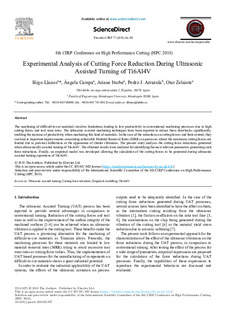Title
Experimental analysis of cutting force reduction during ultrasonic assisted turning of Ti6Al4VAuthor
Author (from another institution)
Publication Date
2019Other institutions
Ideko (Spain)Version
Published versionDocument type
Journal ArticleJournal ArticleLanguage
EnglishRights
© 2018 The authorsAccess
Open accessPublisher’s version
http://dx.doi.org/10.1016/j.procir.2018.08.227Published at
Procedia CIRP Vol. 77. Pp. 86-88. Elsevier, 2019Publisher
Elsevier Ltd.Keywords
Ultrasonic assisted turningCutting force reduction
Empirical modelling
Ti6Al4V
Abstract
The machining of difficult-to-cut materials involves limitations leading to low productivity in conventional machining processes due to high cutting forces and tool wear rates. ... [+]
The machining of difficult-to-cut materials involves limitations leading to low productivity in conventional machining processes due to high cutting forces and tool wear rates. The ultrasonic assisted machining techniques have been reported to reduce these drawbacks significantly, enabling the increase of productivity when machining this kind of materials. In the case of the reductions on cutting forces and their control, they can lead to important improvements concerning achievable Material Removal Rates (MRR) on processes where the maximum cutting forces are limited due to part-tool deflections or the appearance of chatter vibrations. The present study analyses the cutting force reductions generated when ultrasonically assisted turning of Ti6Al4V. The obtained results were analyzed for identifying the most relevant parameters generating such force reductions. Finally, an empirical model was developed allowing the calculation of the cutting forces to be generated during ultrasonic assisted turning operations of Ti6Al4V. [-]
Collections
- Articles - Engineering [763]
The following license files are associated with this item:






















